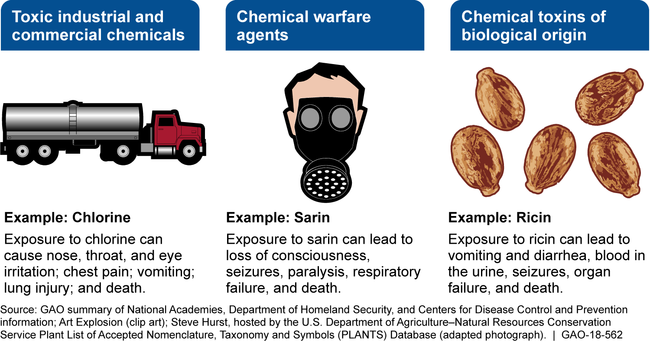Chemical Terrorism: A Strategy and Implementation Plan Would Help DHS Better Manage Fragmented Chemical Defense Programs and Activities
Fast Facts
Recent attacks using chemical agents abroad have sparked concerns about potential similar attacks occurring in the United States. What is the Department of Homeland Security doing about it?
We found that DHS recently consolidated some of its chemical defense programs into a new Countering Weapons of Mass Destruction Office. But several agency's components, including Customs and Border Protection and the U.S. Coast Guard, still run their own programs.
Sharing resources and information department-wide could make DHS's chemical defense more effective. We recommended developing a strategy and implementation plan to better manage chemical defense.

Photo of two people in gas masks, white coverups, and black boots carrying equipment and walking across a lawn
Highlights
What GAO Found
The Department of Homeland Security (DHS) manages several programs and activities designed to prevent and protect against domestic attacks using chemical agents (see figure). Some DHS components have programs that focus on chemical defense, such as the Science and Technology Directorate's (S&T) chemical hazard characterization. Others have chemical defense responsibilities as part of their broader missions, such as U.S. Customs and Border Protection (CBP), which interdicts chemical agents at the border. DHS recently consolidated some chemical defense programs and activities into a new Countering Weapons of Mass Destruction (CWMD) Office.
However, GAO found and DHS officials acknowledged that DHS has not fully integrated and coordinated its chemical defense programs and activities. Several components—including CBP, U.S. Coast Guard, the Office of Health Affairs, and S&T—have conducted similar activities, such as acquiring chemical detectors or assisting local jurisdictions with preparedness, separately, without DHS-wide direction and coordination. As components carry out chemical defense activities to meet mission needs, there is a risk that DHS may miss an opportunity to leverage resources and share information that could lead to greater effectiveness addressing chemical threats. It is too early to tell the extent to which the new CWMD Office will enhance the integration of DHS's chemical defense programs and activities. Given the breadth of DHS's chemical defense responsibilities, a strategy and implementation plan would help the CWMD Office (1) mitigate the risk of fragmentation among DHS programs and activities, and (2) establish goals and identify resources to achieve these goals, consistent with the Government Performance and Results Modernization Act of 2010. This would also be consistent with a 2012 DHS effort, since abandoned, to develop a strategy and implementation plan for all chemical defense activities, from prevention to recovery. DHS officials stated the 2012 effort was not completed because of leadership changes and competing priorities.
Examples of Chemical Agents Used in Attacks and Their Effects

Why GAO Did This Study
Recent chemical attacks abroad and the threat of using chemical weapons against the West by the Islamic State of Iraq and Syria (ISIS) have raised concerns about the potential for chemical attacks occurring in the United States. DHS's chemical defense responsibilities include, among others, managing and coordinating federal efforts to prevent and protect against domestic chemical attacks.
GAO was asked to examine DHS's chemical defense programs and activities. This report examines (1) DHS programs and activities to prevent and protect against domestic chemical attacks and (2) the extent to which DHS has integrated and coordinated all of its chemical defense programs and activities. GAO reviewed documentation and interviewed officials from relevant DHS offices and components and reviewed DHS strategy and planning documents and federal laws and directives related to chemical defense.
Recommendations
GAO recommends that the Assistant Secretary for the CWMD Office develop a strategy and implementation plan to help DHS guide, support, integrate, and coordinate chemical defense programs and activities. DHS concurred with the recommendation and identified actions to address it.
Recommendations for Executive Action
| Agency Affected | Recommendation | Status |
|---|---|---|
| Countering Weapons of Mass Destruction Office |
Priority Rec.
The Assistant Secretary for Countering Weapons of Mass Destruction should develop a strategy and implementation plan to help the Department of Homeland Security, among other things, guide, support, integrate and coordinate its chemical defense programs and activities; leverage resources and capabilities; and provide a roadmap for addressing any identified gaps. (Recommendation 1) |
We found that the Department of Homeland Security (DHS) managed several programs and activities designed to prevent and protect against domestic attacks using chemical agents. DHS consolidated multiple programs, including some chemical defense programs and activities, into the Countering Weapons of Mass Destruction (CWMD) Office in December 2017. However, we found and DHS officials acknowledged that DHS had not fully integrated and coordinated its chemical defense programs and activities. Several components-including CBP, U.S. Coast Guard, the Office of Health Affairs (a legacy element of the CWMD Office), and S&T-conducted similar activities, such as acquiring chemical detectors or assisting local jurisdictions with preparedness, separately, without DHS-wide direction and coordination. Therefore, we recommended that the CWMD Office develop a strategy and implementation plan to help DHS guide, support, integrate, and coordinate chemical defense programs and activities. In response, DHS issued the Chemical Defense Strategy in December 2019. The strategy includes overarching goals and a range of related objectives establishing a departmental approach to combating chemical threats and incidents, according to the document. For example, one strategic goal listed in the strategy is to integrate DHS's chemical defense capabilities. A related objective is to understand federal chemical defense capabilities to avoid duplication and to leverage acquisitions of already developed capabilities. Another related objective includes identifying and addressing any gaps in DHS's chemical defense capabilities. In September 2021, DHS issued an implementation plan that identifies roles and responsibilities for implementing the goals and objectives listed in the Chemical Defense Strategy. Included in the implementation plan is the identification of DHS lead and support components for addressing the objectives described above as well as activities and milestone dates for completion of the objectives. DHS's issuance of the Chemical Defense Strategy and implementation plan is consistent with our recommendation.
|
